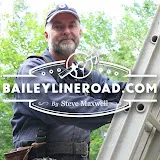0:00
So in this video I want to share a little trick that I use for mixing paint products
0:05
I don't always use this, sometimes as with urethane say for instance
0:10
There's not a whole lot to mix up so I'll just mix it with a stir stick
0:14
But with some paints and especially wood stains, there's a case to be made for power mixing
0:21
which is what I'm going to show you here. So I've got a can of some brown stuff. I really like this color for staining
0:30
Let me just show you the problem. So I mean it looks brown enough right, when you're looking at it
0:36
But the problem with stains is, oh boy, they often build up, look at that
0:41
They often build up solids on the bottom and that's where the color comes from or some of the color
0:47
And it's very important that that whole thing be mixed. That there isn't anything left on the bottom because you're not going to get the kind of coloring action that you want if that's there
0:59
Now I could mix this so that it's homogenous with just this stir stick
1:05
The problem is it's going to take me a long time and there's a very good chance that I'm not actually going to mix it as thoroughly as I should
1:13
So that's where this comes in. This is my paint mixing paddle
1:20
And once upon a time it used to be one of these. It used to be a spade bit
1:27
But I retired it, or rather reassigned it for another job. I ground off, you can see I ground off most of the spur because if the spur is long I can't get to the bottom of the paint can
1:38
So I ground off most of it and I just use that one for all kinds of paint
1:43
Sometimes house paint, sometimes stain, sometimes some outdoor wood finishes. Now there's a couple of things I've got to warn you about here
1:53
If you have this thing set to go really fast, well chances are excellent whatever you're stirring is going to come flying out
2:01
So you want to be careful. You don't want to rev it up too much. You don't really need to
2:06
And you want to make sure you're, it's really the bottom that we're working on. That's where all the stuff has developed, all the sediment
2:12
So we want to get it right down to the bottom. You're going to see I'm going to rotate it around the can, sort of move it back and forth, cover all the areas
2:21
Then I'm also going to reverse the rotation and spin it the other way just to make things a little more mixed
2:28
But it's really a pretty simple process. Now what I want you to look at here is how the appearance of this stain changes
2:37
Because right now it looks like black coffee, which is darker than the stain is supposed to be
2:43
Because all the good stuff is at the bottom. But as I mix..
2:57
We're starting to see some lighter brown come up. You see that
3:02
So I'm going around in a circle to make sure I get all the stuff on the bottom and then I go back and forth
3:21
I'm also going up and down a little bit. Pull that lighter stuff up from the bottom
3:32
Now this mixing, as you can see, it's not happening immediately even with this power tool
3:41
So you can get a sense of how long it would take to mix thoroughly by hand, just with a stick
3:56
I'm going to reverse rotation a bit. I'm not sure that that helps, but I'm kind of thinking it might. It can't hurt
4:08
Now that looks pretty even to me. Now that's pretty even and it's ready to go
4:24
Now I would normally be doing this right before I'm staining. So I would have a brush and a rag and I would clean this off and then use some of that on the wood that I'm going to be staining
4:34
But it gives you the idea. And power mixing like this really helps with a lot of different finishing substances that you're likely to use


